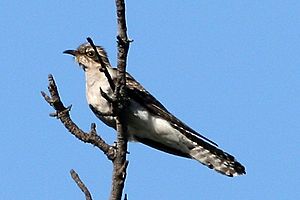Pallid cuckoo facts for kids
Quick facts for kids Pallid cuckoo |
|
|---|---|
 |
|
| Conservation status | |
| Scientific classification | |
| Genus: |
Cacomantis
|
| Species: |
pallidus
|
| Synonyms | |
|
Cuculus pallidus, Heteroscenes pallidus |
|
The pallid cuckoo (Cacomantis pallidus) is a type of cuckoo bird. It lives in Australia and sometimes flies to islands like Timor and Papua New Guinea. These birds are about 28 to 33 centimeters long. They have special features like a dark beak, dark eyes with a gold ring around them, and olive-grey feet. These features help tell them apart from other cuckoos. Young pallid cuckoos can sometimes look like the oriental cuckoo.
Contents
How Scientists Name and Group Pallid Cuckoos
In 1801, an English bird expert named John Latham first described the pallid cuckoo. He called it Columba pallida, which means "pale pigeon".
Scientists sometimes disagree about which group (genus) this bird belongs to. It is often placed in the Cuculus group. However, studies of its genes and its unique song suggest it belongs in the Cacomantis group. Its closest relative seems to be the white-crowned cuckoo (Cacomantis leucolophus).
The International Ornithological Committee (IOC) has officially named it the "pallid cuckoo". Other common names for this bird include unadorned cuckoo, semitone-bird, scale-bird, and brain-fever bird. This last name comes from its loud, repeating call.
What the Pallid Cuckoo Looks Like
The pallid cuckoo has several key features that help identify it. It has a dark beak and dark eyes with a bright gold ring around them. There is a faint dark mark that goes from its eye down its neck. It also has a white or light brown mark on the back of its neck. Its feet are olive-grey, and its long tail has clear white or light brown markings along the edges.
When the pallid cuckoo flies, you can see noticeable white and dark stripes across its long tail. Its shape in the air looks a bit like a falcon. This often makes smaller birds give alarm calls, thinking a predator is near. Pallid cuckoos can have different color forms, including a light reddish-brown type or a dark reddish-brown type.
Adult male pallid cuckoos have grey-brown feathers on their upper body, including their head and neck. They also have large spots on their wing feathers. Adult female pallid cuckoos can look similar to males if they are the light reddish-brown type. However, if they are the dark reddish-brown type, the neck patch extends further, and they have stripes on their chest.
A special feature of all cuckoos is their feet. They have "zygodactyl" feet. This means two of their toes point forward, and two point backward. This helps them grip branches very well.
Where Pallid Cuckoos Live and Their Homes
The pallid cuckoo lives all over mainland Australia and in Tasmania. During the winter months, these cuckoos spend their time in central Australia and the Northern Territory. Then, they fly to the coastal areas of South East Australia and Tasmania. They usually arrive there around September or October.
Sometimes, pallid cuckoos also migrate to the islands of Timor and Papua New Guinea in winter. They are very rarely seen in New Zealand.
Pallid cuckoos can be found in many different places. These include woodlands, shrublands, mangrove forests, farms, golf courses, and even gardens. However, they prefer open areas with scattered trees and bushes. They like places with not too much undergrowth, as this helps them hunt for food.
What Pallid Cuckoos Eat
The pallid cuckoo mainly eats insects, especially caterpillars. They hunt by hopping down from a high spot, like a tree branch. They then grab their prey either from trees or from the grass. They particularly like to eat hairy caterpillars.
Life Cycle and Reproduction
Pallid cuckoos lay their eggs between July and December. The pallid cuckoo is a "brood parasite." This means it lays its eggs in the nests of other bird species. It then leaves its egg for the other bird to care for. If the host bird does not notice the extra egg, it will raise the cuckoo chick as its own.
Pallid cuckoos have been known to use over 100 different kinds of passerine birds as hosts. However, most of their main host birds belong to the honeyeater family. Common host species include honeyeaters, Australasian robins, and willy wagtails.
See also
 In Spanish: Cuco pálido para niños
In Spanish: Cuco pálido para niños



